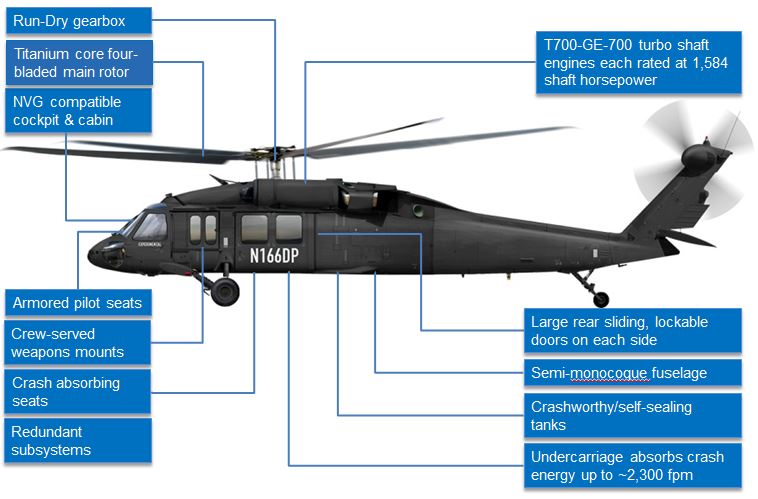Trip Ready: Making Certain Optimum Problem for Your UH 60 Helicopter
Trip Ready: Making Certain Optimum Problem for Your UH 60 Helicopter
Blog Article
Browsing Uh 60 Helicopter Laws and Compliance Demands

Regulatory Structure Summary
The regulative framework governing UH-60 helicopter procedures includes a complicated set of criteria and policies established by aviation authorities. These laws are created to make sure the reliable and risk-free operation of UH-60 helicopters in numerous atmospheres. The Federal Aviation Management (FAA) plays a central function in developing and imposing these regulations, which cover a vast variety of functional elements, including airworthiness standards, pilot certifications, maintenance requirements, and operational procedures.
Compliance with these policies is crucial for helicopter drivers to preserve the highest levels of security and functional stability. Failing to stick to these policies can cause major consequences, including mishaps, injuries, and regulatory permissions. Helicopter operators should remain educated regarding the most recent regulatory advancements and make certain that their operations are in full compliance with all relevant rules and requirements.
Airworthiness Instructions and Inspections
Amidst the regulatory framework governing UH-60 helicopter operations, a vital emphasis exists on conformity with Airworthiness Directives and carrying out thorough evaluations to support security requirements and operational dependability. Airworthiness Regulations (ADs) are issued by aviation authorities to address unsafe conditions in aircraft, consisting of the UH-60 helicopter, and required specific actions to be taken by drivers or proprietors. Compliance with ADs is mandatory, and failing to follow these instructions can cause severe repercussions, including grounding of the aircraft.
Regular assessments are paramount to making sure the airworthiness of UH-60 helicopters. By adhering to a stringent examination program, operators can find and address prospective concerns quickly, consequently enhancing the security and integrity of UH-60 helicopter procedures.
Pilot Qualifications and Training

Pilot training for UH-60 helicopters is extensive and covers a vast array of subjects, including airplane systems, emergency treatments, navigation, and mission-specific training. Furthermore, pilots undergo simulator training to practice numerous emergency circumstances in a controlled atmosphere. This training helps pilots establish the essential skills to take care of challenging circumstances effectively.


Furthermore, ongoing training and specialist advancement are necessary for UH-60 pilots to stay current with the most up to date regulations, modern technology, and ideal methods. By purchasing pilot qualifications and training, drivers can improve safety, maximize efficiency, and guarantee compliance with governing demands in the operation of UH-60 helicopters.
Functional Limitations and Demands
Pilot certifications and training work as the structure for comprehending the operational constraints and demands associated with UH-60 helicopter procedures (uh 60). These operational constraints are implemented to make certain the security of the crew, guests, and the aircraft itself. Functional restrictions might consist of factors such as climate conditions, weight constraints, altitude restraints, and operational borders. It is essential for pilots to be fluent in these restrictions to make enlightened decisions throughout flight operations. In addition, compliance needs, such as adhering to certain flight paths, interaction protocols, and emergency situation treatments, are vital for keeping operational safety and security and regulatory compliance. Pilots have to stay existing with all operational linked here restrictions and needs through routine training, instructions, and evaluates to minimize risks and make sure effective and risk-free UH-60 helicopter procedures. By prioritizing adherence to these operational standards, pilots can boost the total safety and efficiency of their goals while supporting regulative criteria.
Emergency Situation Procedures and Conformity Testing
Reliable emergency situation treatments and complete compliance testing are crucial components of published here maintaining functional safety and security and regulative adherence in UH-60 helicopter operations. Emergency treatments include protocols for various circumstances, consisting of engine failures, fires, hydraulic issues, and extra. Pilots and team members must be fluent in these procedures to react quickly and efficiently in emergencies. Normal conformity testing makes certain that the helicopter satisfies all regulatory demands stated by aeronautics authorities. This screening involves detailed examinations, checks, and assessments to confirm that the airplane is airworthy and in compliance with all relevant policies.
Compliance screening also encompasses tools onboard the UH-60, such as communication systems, navigating tools, and security equipment. Ensuring that all devices is operating correctly and satisfies governing standards is necessary for secure operations. Furthermore, conformity screening may include simulations of emergency situation scenarios to evaluate the staff's response and the helicopter's performance under anxiety. By focusing on emergency situation procedures and compliance testing, UH-60 drivers can mitigate dangers and show their dedication to safety and regulatory compliance.
Final Thought
In verdict, adherence to governing framework, compliance with airworthiness regulations, pilot certifications and training, operational restrictions, and emergency treatments are necessary for navigating the regulations and requirements of operating a UH-60 helicopter. uh 60. It is page important for operators to prioritize safety and guarantee full compliance with all appropriate policies to maintain the airworthiness and operational integrity of the aircraft
Browsing the governing landscape bordering UH-60 helicopter operations demands a nuanced understanding of the intricate internet of regulations and conformity demands.Compliance with these policies is important for helicopter operators to keep the greatest levels of security and operational honesty.Among the regulative framework controling UH-60 helicopter operations, a vital focus exists on compliance with Airworthiness Directives and conducting detailed examinations to maintain safety criteria and operational integrity.Efficient emergency treatments and complete compliance screening are vital components of preserving operational security and regulatory adherence in UH-60 helicopter procedures. Regular conformity testing makes sure that the helicopter meets all governing requirements established forth by aviation authorities.
Report this page